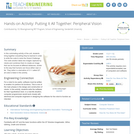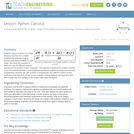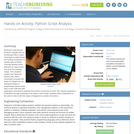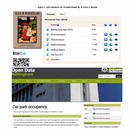
This lesson plan uses Ozobots and their color code commands coding to review Geometry concepts.
- Subject:
- Applied Science
- Computer Science
- Geometry
- Mathematics
- Material Type:
- Activity/Lab
- Date Added:
- 05/12/2021

This lesson plan uses Ozobots and their color code commands coding to review Geometry concepts.

In this culminating activity of the unit, students bring together everything they've learned in order to write the code to solve the Grand Challenge. The code solution takes two images captured by robots and combines them to create an image that can be focused at different distances, similar to the way that humans can focus either near or far. They write in a derivative of C++ called QT; all code is listed in this activity.

Students analyze a cartoon of a Rube Goldberg machine and a Python programming language script to practice engineering analysis. In both cases, they study the examples to determine how the different systems operate and the function of each component. This exercise in juxtaposition enables students to see the parallels between a more traditional mechanical engineering design and computer programming. Students also gain practice in analyzing two very different systems to fully understand how they work, similar to how engineers analyze systems and determine how they function and how changes to the system might affect the system.

Working in small groups, students complete and run functioning Python codes. They begin by determining the missing commands in a sample piece of Python code that doubles all the elements of a given input and sums the resulting values. Then students modify more advanced Python code, which numerically computes the slope of a tangent line by finding the slopes of progressively closer secant lines; to this code they add explanatory comments to describe the function of each line of code. This requires students to understand the logic employed in the Python code. Finally, students make modifications to the code in order to find the slopes of tangents to a variety of functions.

This course on software engineering covers design and implementation of medium-scale software systems, using web applications as a platform. In the course, students learn the fundamentals of structuring a web application and writing modular code, with an emphasis on conceptual design to achieve clarity, simplicity, and modularity. Topics also include functional programming, relational databases, and security.

A collection of programming tutorials developed by Andrew Cain, Jake Renzella, Reuben Wilson, and Cliff Warren.
This series steps through concepts related to procedural programming. Each video covers one concept in depth and demonstrates how you can achieve certain tasks with a programming language. Videos are broken into panels for an engaging student experience, featuring camera footage, visualisation of the computer’s memory (hand execution), and output windows. Video and audio versions are available for download, along with supplementary files.

Template zur Code Week 2014

As part of our NSF-funded passion-driven statistics project, we have just started to share more widely our “translation code” aimed at supporting folks in learning code-based software and in moving more easily between them. The pdf includes all of the basic syntax for managing, displaying and analyzing data, translated across SAS, R, Python, Stata and SPSS.

Students learn about homeostasis and create models by constructing simple feedback systems using Arduino boards, temperature sensors, LEDs and Arduino code. Starting with pre-written code, students instruct LEDs to activate in response to the sensor detecting a certain temperature range. They determine appropriate temperature ranges and alter the code accordingly. When the temperature range is exceeded, a fan is engaged in order to achieve a cooling effect. In this way, the principle of homeostasis is demonstrated. To conclude, students write summary paragraphs relating their models to biological homeostasis.

This case study is retrieved from the open book Open Data as Open Educational Resources. Case studies of emerging practice.
It explores why and how open data can be used as a material with which to produce engaging challenges for students as they are introduced to programming. Through describing the process of producing the assignments, and learner responses to them, we suggest that open data is a powerful material for designing learning activities because of its qualities of ease of access and authenticity.
In two successive years, forms of open data were used to construct coursework assignments for postgraduate students at the University of Nottingham, UK. The rationale for using open data was to shift the focus towards an outward-looking approach to coding with networks, files and data structures, and to engage students in constructing applications that had real-world relevance.
Python was chosen as the programming language.
The assignment in the first year utilised e-book text files from Project Gutenberg1, and required students to build an e-reader application. In the next year, car park status data, which was made available in a regularly updated form by the city council through their open data initiative2 was used as the basis for an assignment in which students developed a city-wide car park monitoring application.